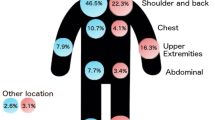Abstract
Objective
To describe the incidence of second primary invasive melanoma.
Methods
Data describing 52,997 subjects with melanoma notified to The Queensland Cancer Registry between 1982 and 2003. We calculated incidence rates of second primary invasive melanoma (per 1,000 person-years) by sex, age, and characteristics of the first primary.
Results
The rate of second primary invasive melanoma was relatively constant over 20 years of follow-up at 6.01 per 1,000 person-years indicating a high, constant lifetime risk of second primary invasive melanoma. Rates were 62% higher in males than in females and increased with age at first diagnosis with the rate in older patients (80+ years) more than double the rate observed in younger patients (40–49 years). Rates in patients with melanomas thicker than 2 mm were over 50% higher than in patients with thinner melanomas.
Conclusions
Melanoma patients are at high risk of a second primary invasive melanoma. This risk does not diminish with time and does not differ significantly between patients first diagnosed with lentigo maligna, in situ melanoma or invasive melanoma. These results indicate that all melanoma patients require lifetime surveillance. Current treatment guidelines should be modified to reflect this.


Similar content being viewed by others
References
Parkin DM, Whelan SL, Ferlay J, Teppo L, Thomas DB (2002) Cancer in five continents vol VIII. IARC Scientific Publications No 155. Lyon, France: International agency for cancer research and International association of cancer registries. Report No.: IARC Scientific Publication No 155
Coory M, Baade P, Aitken J, Smithers M, McLeod GR, Ring I (2006) Trends for in situ and invasive melanoma in Queensland, Australia, 1982–2002. Cancer Causes Control 17(1):21–27
Moseley HS, Giuliano AE, Storm FK 3rd, Clark WH, Robinson DS, Morton DL (1979) Multiple primary melanoma. Cancer 43(3):939–944
Kang S, Barnhill RL, Mihm MC Jr, Sober AJ (1992) Multiple primary cutaneous melanomas. Cancer 70(7):1911–1916
Slingluff CL Jr, Vollmer RT, Seigler HF (1993) Multiple primary melanoma: incidence and risk factors in 283 patients. Surgery 113(3):330–339
Johnson TM, Hamilton T, Lowe L (1998) Multiple primary melanomas. J Am Acad Dermatol 39(3):422–427
Bhatia S, Estrada-Batres L, Maryon T, Bogue M, Chu D (1999) Second primary tumors in patients with cutaneous malignant melanoma. Cancer 86(10):2014–2020
DiFronzo LA, Wanek LA, Elashoff R, Morton DL (1999) Increased incidence of second primary melanoma in patients with a previous cutaneous melanoma. Ann Surg Oncol 6(7):705–711
Burden AD, Vestey JP, Sirel JM, Aitchison TC, Hunter JA, MacKie RM (1994) Multiple primary melanoma: risk factors and prognostic implications. BMJ 309(6951):375
Giles G, Staples M, McCredie M, Coates M (1995) Multiple primary melanomas: an analysis of cancer registry data from Victoria and New South Wales. Melanoma Res 5(6):433–438
Goggins WB, Tsao H (2003) A population-based analysis of risk factors for a second primary cutaneous melanoma among melanoma survivors. Cancer 97(3):639–643
Francken AB, Bastiaannet E, Hoekstra HJ (2005) Follow-up in patients with localised primary cutaneous melanoma. Lancet Oncol 6(8):608–621
Garbe C, Paul A, Kohler-Spath H, Ellwanger U, Stroebel W, Schwarz M et al (2003) Prospective evaluation of a follow-up schedule in cutaneous melanoma patients: recommendations for an effective follow-up strategy. J Clin Oncol 21(3):520–529
Levi F, Randimbison L, Te VC, La Vecchia C (2005) High constant incidence rates of second cutaneous melanomas. Int J Cancer 117(5):877–879
Chow GC (1960) Tests of equality between sets of coefficients in two linear regressions. Econometrica 28(3):591–605
Belsley DA, Kuh E, Welsch RE (1980) Regression diagnostics: identifying influential data and sources of collinearity. John Wiley & Sons, New York
Greenland S, Finkle WD (1995) A critical look at methods for handling missing covariates in epidemiologic regression analyses. Am J Epidemiol 142(12):1255–1264
van Buuren S, Boshuizen HC, Knook DL (1999) Multiple imputation of missing blood pressure covariates in survival analysis. Stat Med 18(6):681–694
Rubin DB (1976) Inference and missing data. Biometrika 63(3):581–592
Gupta BK, Piedmonte MR, Karakousis CP (1991) Attributes and survival patterns of multiple primary cutaneous malignant melanoma. Cancer 67(7):1984–1989
Brobeil A, Rapaport D, Wells K, Cruse CW, Glass F, Fenske N et al (1997) Multiple primary melanomas: implications for screening and follow-up programs for melanoma. Ann Surg Oncol 4(1):19–23
Ferrone CR, Ben Porat L, Panageas KS, Berwick M, Halpern AC, Patel A et al (2005) Clinicopathological features of and risk factors for multiple primary melanomas. JAMA 294(13):1647–1654
Levi F, La Vecchia C, Randimbison L, Te VC, Erler G (1997) Incidence of invasive cancers following cutaneous malignant melanoma. Int J Cancer 72(5):776–779
Wassberg C, Thorn M, Yuen J, Ringborg U, Hakulinen T (1996) Second primary cancers in patients with cutaneous malignant melanoma: a population-based study in Sweden. Br J Cancer 73(2):255–259
Silcock H (1959) The comparison of occupational mortality rates. Popul Stud 13(2):183–192
Kilpatrick SJ (1963) Mortality comparisons in socio-economic groups. Appl Stat 12(2):65–86
NHMRC (1999) The management of cutaneous melanoma. Commonwealth of Australia, Canberra
Queensland Cancer Registry (2007) Cancer in Queensland. Incidence and mortality 1982 to 2004. Statistical tables. Brisbane, Queensland Cancer Fund, Queensland Health
Author information
Authors and Affiliations
Corresponding author
Rights and permissions
About this article
Cite this article
McCaul, K.A., Fritschi, L., Baade, P. et al. The incidence of second primary invasive melanoma in Queensland, 1982–2003. Cancer Causes Control 19, 451–458 (2008). https://doi.org/10.1007/s10552-007-9106-5
Received:
Accepted:
Published:
Issue Date:
DOI: https://doi.org/10.1007/s10552-007-9106-5




